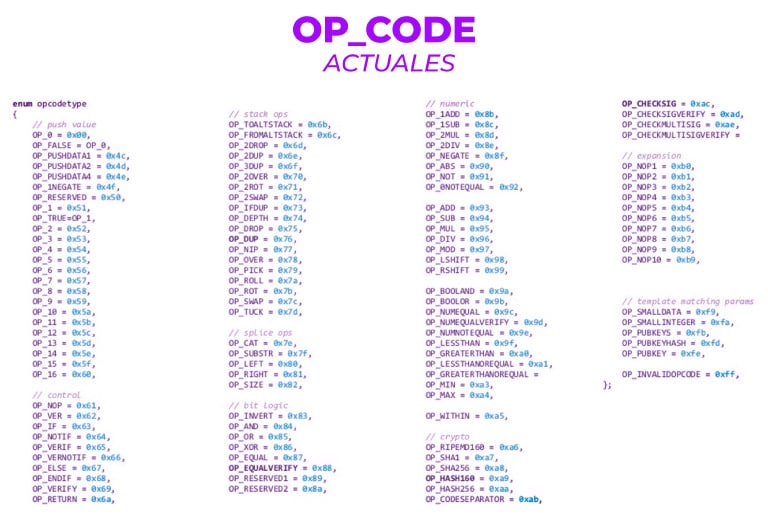
Table of Contents
ToggleIn real life, usually, to avoid procrastination and reach our New Year’s ideal, which is to be more productive than in previous years, we create a complete plan with schedules and activities to be performed.
Eventually, the incredible thing is in the will to start doing it. But when that day comes when we wake up saying “come on, we can do it today” is when everything starts to become a reality, even if temporary, effective, since it leads us to act. Essentially, this is how the OP_CODE or, also called, operating codes or operation codes work.
Want to know how they work and what makes them so indispensable in the crypto universe? You’re in the best place! Get your luggage ready, today we will take a trip through the world of programming.
What is OP_CODE?
Starting with “what is an OP_CODE”, better called operation code, it can be defined as an instruction that specifies the operation to be performed by the virtual machines.
This command is generated in assembly language or machine language that specifies or translates it into a collection of binary digits or bits (0 and 1).
Within the world of cryptos, it facilitates the programming process within a blockchain, either in the creation of advanced programming structures or the famous smart-contracts that are reviewed and executed by the different nodes of a blockchain such as Ethereum or Bitcoin.
As mentioned earlier, more simply, OP_CODEs are a call to action.
In the situation of our New Year’s resolutions, it would be our motivation. That one that makes us, at least on that day, get up and go to the gym or start working.
Precisely, this is what would be an operating code for a system or a computer.
However, before we jump into more of our subject matter and understand how it works, it is important to recognize that these OP_CODEs work for both hardware and software. However, their formats are set up differently.
- On the hardware side, the operating codes are set and operate according to the instruction set architecture (ISA), which defines the types of data that are supported, the registers, the support for managing the main memory or other elements such as memory consistency or the input/output model. An example of an ISA is the “x86” family of Intel or AMD processors, which includes processors ending with “86” such as the 80186, 80268, 80286, among others, whose function is to address more memory than can be covered by a simple 16-bit address.
- In the case of software, OP_CODE are also called bytecodes or byte codes, which are intended to be interpreted by software, rather than by a hardware device, and therefore use more complex data and operations than hardware ones, but are built on similar lines. An example of this type of codes can be found in the java class files that are interpreted by a Java Virtual Machine (JVM).
How does an OP_CODE work? Let’s talk about machine languages and operands.
Implicit in its operating mechanism is the way in which the order is presented or, in other words, the language it uses.
For these purposes, the programming language is an essential tool and is consolidated as the main option for the presentation of data and the proper operation of this type of procedures.
For this reason, it is common for the operation codes to be in English and, consequently, for their processing, to make use of binary values.
From there, the opcode identifies the operation to be performed and the set of instructions needed for that process.
In this part, there is also another important component which are the operands.
To explain this, let’s first start with an example: we are at a party and we were given a piece of cake with two levels: if the opcode or operation code is the portion corresponding to the first level of the cake, the operands would be the other level, thus completing a wonderful dish.
For this reason, operands and OP_CODEs are inseparable twin brothers who, in some circumstances more than others, need each other to carry out a function, since both are portions of an instruction.
On the one hand, we understand that the OP_CODE can be translated into observable acts or facts. The operand is the variables that are involved in this process or, in other words, the values or subjects included.
If we were in the mood to make paella, the operating code would be the techniques and procedures that must be carried out to cook the rice, the breast, the pork ribs, among others; and the operator would be the cook, who is in charge of getting all the ingredients and having them ready for the preparation of the recipe.
Consequently, the operation code would be a verb, while the operand would be the subject.
For this reason, we can understand two things: if we want the intended actions to be executed inside a blockchain, it is necessary to use the OP_CODE in a suitable language so that it can be processed inside it by the CPU or other hardware/software and to define the operands (registers, addresses, labels, values, etc.) with which the instruction will operate.
Trading codes for cryptos such as Bitcoin
All cryptos make use of opcode (operation code) or operation codes, which make it possible to handle transactions or operations within your system.
A clear example of this is presented by Bitcoin. Currently, “script” is the language used to lock and unlock transactions.
For this language, there are about 10 types of special codes for different functions, such as constants (the current), flow control, stack and splicing operations, bit logic, numeric operations, crypt operations, time locking, pseudocodes (used to adjust transactions) and reserved codes.
Let’s conclude this journey by looking at a few of the different types of trading codes that can be found in the Bitcoin script:

So much for our journey. If you are interested in reading more articles associated with the news of the crypto universe and its basic concepts, you can click on the related topics below.
If you want to join this fascinating adventure of cryptocurrencies, you can go to our home page and check our services. We will always be ready to answer your questions and support you in whatever you need, see you next time!







